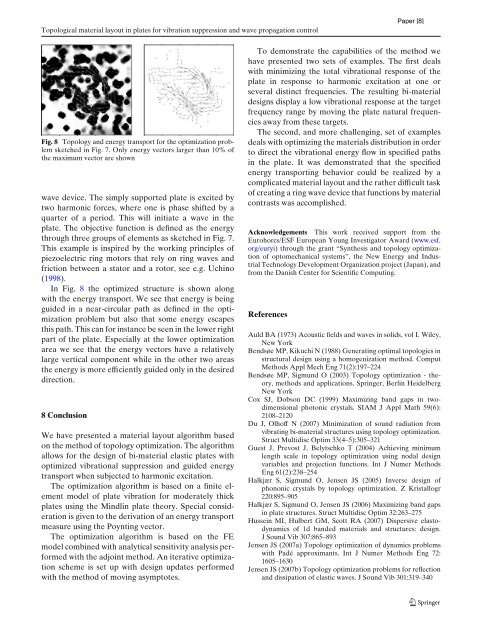WAVES AND VIBRATIONS IN INHOMOGENEOUS STRUCTURES ...
WAVES AND VIBRATIONS IN INHOMOGENEOUS STRUCTURES ...
WAVES AND VIBRATIONS IN INHOMOGENEOUS STRUCTURES ...
You also want an ePaper? Increase the reach of your titles
YUMPU automatically turns print PDFs into web optimized ePapers that Google loves.
Topological material layout in plates for vibration suppression and wave propagation control<br />
Fig. 8 Topology and energy transport for the optimization problem<br />
sketched in Fig. 7. Only energy vectors larger than 10% of<br />
the maximum vector are shown<br />
wave device. The simply supported plate is excited by<br />
two harmonic forces, where one is phase shifted by a<br />
quarter of a period. This will initiate a wave in the<br />
plate. The objective function is defined as the energy<br />
through three groups of elements as sketched in Fig. 7.<br />
This example is inspired by the working principles of<br />
piezoelectric ring motors that rely on ring waves and<br />
friction between a stator and a rotor, see e.g. Uchino<br />
(1998).<br />
In Fig. 8 the optimized structure is shown along<br />
with the energy transport. We see that energy is being<br />
guided in a near-circular path as defined in the optimization<br />
problem but also that some energy escapes<br />
this path. This can for instance be seen in the lower right<br />
part of the plate. Especially at the lower optimization<br />
area we see that the energy vectors have a relatively<br />
large vertical component while in the other two areas<br />
the energy is more efficiently guided only in the desired<br />
direction.<br />
8 Conclusion<br />
We have presented a material layout algorithm based<br />
on the method of topology optimization. The algorithm<br />
allows for the design of bi-material elastic plates with<br />
optimized vibrational suppression and guided energy<br />
transport when subjected to harmonic excitation.<br />
The optimization algorithm is based on a finite element<br />
model of plate vibration for moderately thick<br />
plates using the Mindlin plate theory. Special consideration<br />
is given to the derivation of an energy transport<br />
measure using the Poynting vector.<br />
The optimization algorithm is based on the FE<br />
model combined with analytical sensitivity analysis performed<br />
with the adjoint method. An iterative optimization<br />
scheme is set up with design updates performed<br />
with the method of moving asymptotes.<br />
To demonstrate the capabilities of the method we<br />
have presented two sets of examples. The first deals<br />
with minimizing the total vibrational response of the<br />
plate in response to harmonic excitation at one or<br />
several distinct frequencies. The resulting bi-material<br />
designs display a low vibrational response at the target<br />
frequency range by moving the plate natural frequencies<br />
away from these targets.<br />
The second, and more challenging, set of examples<br />
deals with optimizing the materials distribution in order<br />
to direct the vibrational energy flow in specified paths<br />
in the plate. It was demonstrated that the specified<br />
energy transporting behavior could be realized by a<br />
complicated material layout and the rather difficult task<br />
of creating a ring wave device that functions by material<br />
contrasts was accomplished.<br />
Acknowledgements This work received support from the<br />
Eurohorcs/ESF European Young Investigator Award (www.esf.<br />
org/euryi) through the grant “Synthesis and topology optimization<br />
of optomechanical systems”, the New Energy and Industrial<br />
Technology Development Organization project (Japan), and<br />
from the Danish Center for Scientific Computing.<br />
References<br />
Auld BA (1973) Acoustic fields and waves in solids, vol I. Wiley,<br />
New York<br />
Bendsøe MP, Kikuchi N (1988) Generating optimal topologies in<br />
structural design using a homogenization method. Comput<br />
Methods Appl Mech Eng 71(2):197–224<br />
Bendsøe MP, Sigmund O (2003) Topology optimization - theory,<br />
methods and applications. Springer, Berlin Heidelberg<br />
New York<br />
Cox SJ, Dobson DC (1999) Maximizing band gaps in twodimensional<br />
photonic crystals. SIAM J Appl Math 59(6):<br />
2108–2120<br />
Du J, Olhoff N (2007) Minimization of sound radiation from<br />
vibrating bi-material structures using topology optimization.<br />
Struct Multidisc Optim 33(4–5):305–321<br />
Guest J, Prevost J, Belytschko T (2004) Achieving minimum<br />
length scale in topology optimization using nodal design<br />
variables and projection functions. Int J Numer Methods<br />
Eng 61(2):238–254<br />
Halkjær S, Sigmund O, Jensen JS (2005) Inverse design of<br />
phononic crystals by topology optimization. Z Kristallogr<br />
220:895–905<br />
Halkjær S, Sigmund O, Jensen JS (2006) Maximizing band gaps<br />
in plate structures. Struct Multidisc Optim 32:263–275<br />
Hussein MI, Hulbert GM, Scott RA (2007) Dispersive elastodynamics<br />
of 1d banded materials and structures: design.<br />
J Sound Vib 307:865–893<br />
Jensen JS (2007a) Topology optimization of dynamics problems<br />
with Padé approximants. Int J Numer Methods Eng 72:<br />
1605–1630<br />
Jensen JS (2007b) Topology optimization problems for reflection<br />
and dissipation of elastic waves. J Sound Vib 301:319–340

















